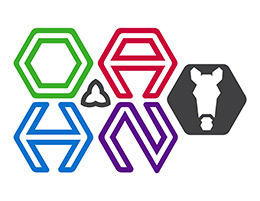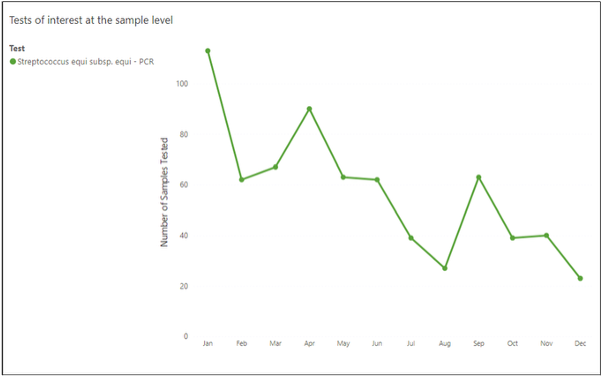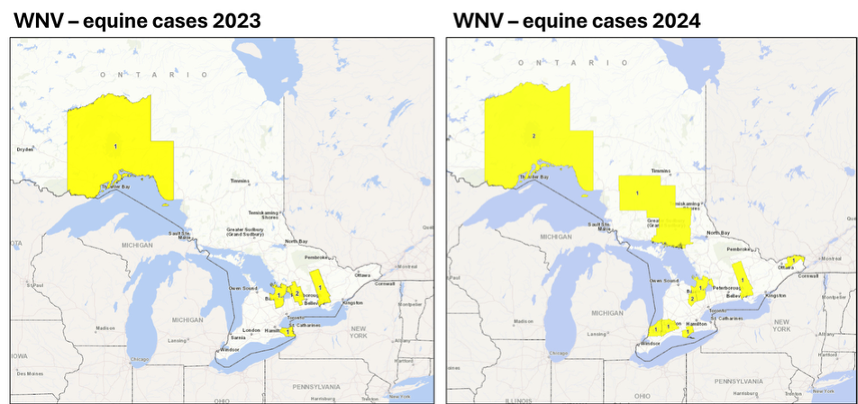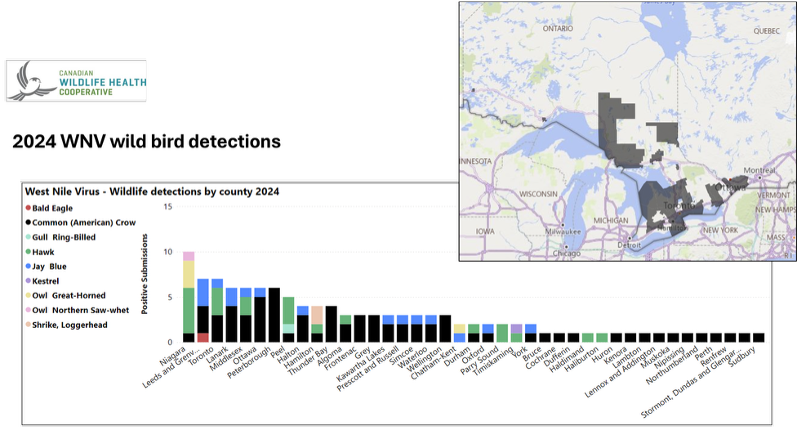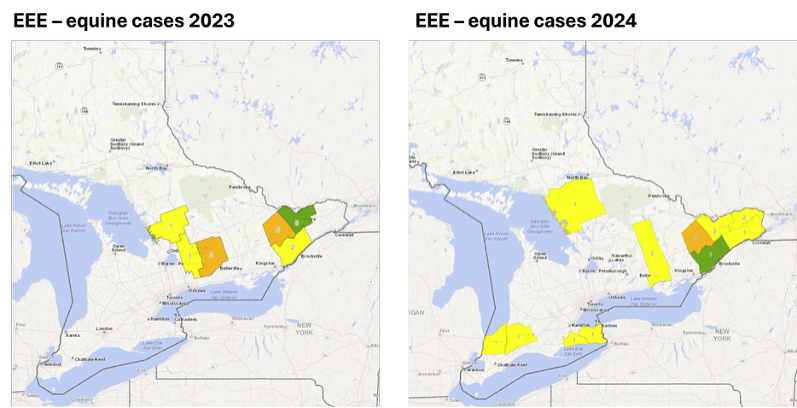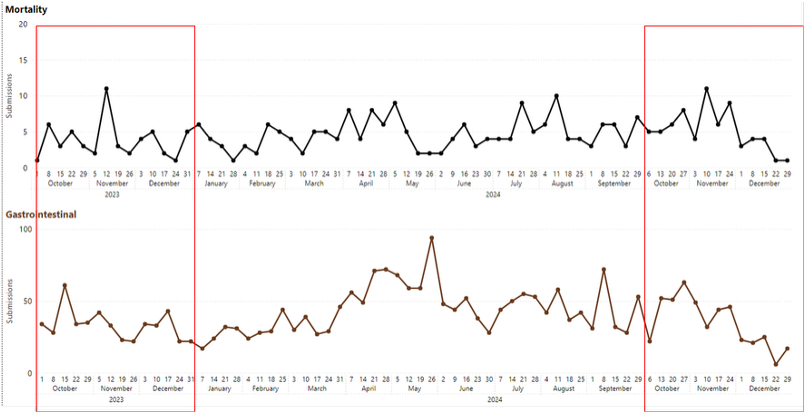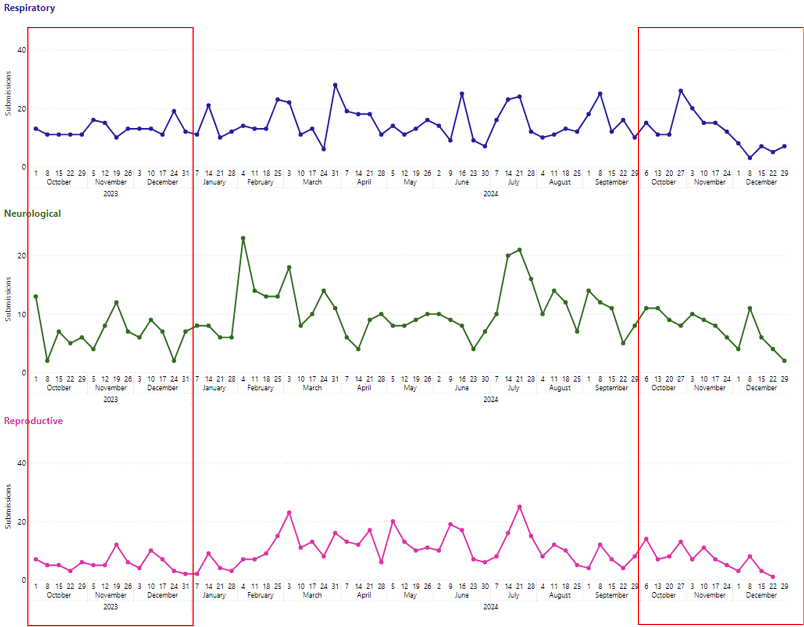Ontario Animal Health Network (OAHN)
Equine Expert Network
Quarterly Veterinary Report
Strangles and EHV-1 Resources
The OAHN Equine network has put together a list of Strangles and EHV-1 resources for veterinarians and owners. They are available at:
- Equine Strangles Resources – Ontario Animal Health Network (oahn.ca)
- Equine Herpesvirus-1 Resources – Ontario Animal Health Network (oahn.ca)
The Ontario map of facilities dealing with Strangles and EHM can be found here:
Equine Disease Tracking Network v 2.1 (arcgis.com)
Strangles and EHM alert notifications are available at:
- Ontario Equine Disease Alerts – Ontario Animal Health Network (oahn.ca)
- Outbreaks | Equine Disease Communication Center (equinediseasecc.org
Interested in participating in our Strangles research project?
We are still looking for samples from clinically affected horses.
Go here for more information!
BITS ‘N SNIPS (or “things we talked about on the network call”)
Contracted tendons in foals was one theme in our quarterly discussion. Please see the infographic below regarding limb deformities in foals and gestation length.
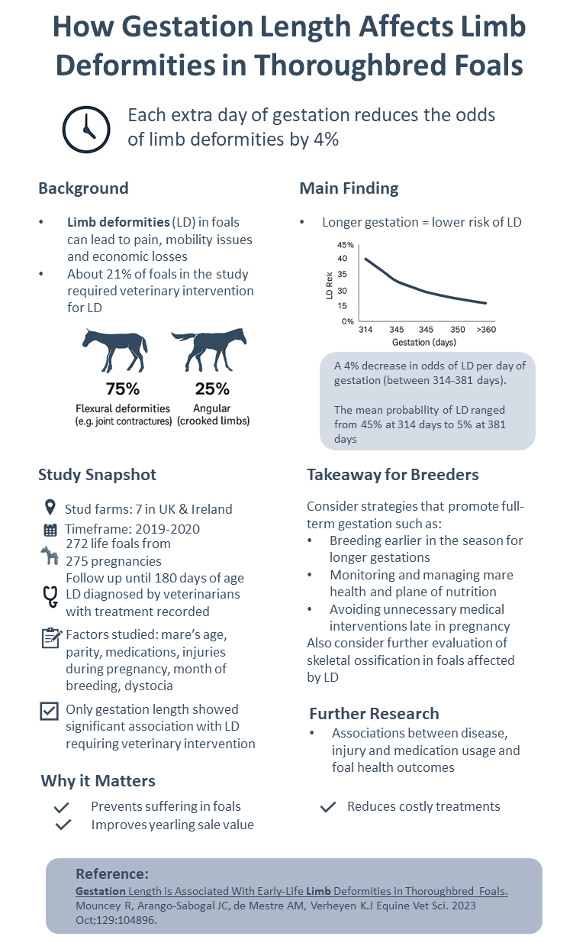
Network Member Reports
|
Southwestern Region (Melissa McKee) |
Winter got off to a later start. We’ve seen diarrhea cases persist into Christmas and now are seeing more impaction colics in older horses or those with poor teeth. Lice has also started to appear. Track rash has stabilized. We are diagnosing far fewer strangles cases. Quite a few tricky corneal ulcers which require intensive care or don’t clear as quickly. No shifts in asthma cases. The respiratory outbreak in Standardbreds seems to be lingering with lots of younger horses with nasal discharge and coughing without fevers and with normal blood work. |
|
Western Region (Tara Foy) |
Fairly stable. We had the typical post yearling sale with a lot of sick babies. We’ve had typical sick weanlings with persistent snotty noses but all are getting over that. We’ve had a few abortions, the usual colics and resolving mud fever with the drier weather. |
|
Eastern Ontario (John Donovan) |
We’ve had an increase in Anaplasma and Lyme cases this fall with most being responsive to therapy. We treat one every couple of weeks. Given that the nymph kill was poor last winter we’ve had a bigger tick problem his year. We’ve had a number of EEE cases, some WNV, and an EHV-1 outbreak in a heavy traffic barn but with no deaths. We’ve also had a lot of respiratory problems this fall due to poor hay quality and closing up the barns for winter; equine asthma and an increase in sinusitis cases (responsive to antibiotics). One of our vets had an interesting case of equine multinodular pulmonary fibrosis (EMPF); a non-responsive respiratory disease (high fever, difficulty breathing) that tested positive for EHV-5 and was euthanized. We’ve seen typical colics (spasmodic and impactions) with weather and grass. The majority did quite well. Later in Q4 we started to see and increase in fecal water syndrome and diarrhea cases. We had some late oxytetracycline-responsive diarrhea cases (later in the year than normal). Now we are dealing with fall laminitis. Not more than usual but prevalent. Also, we are seeing typical skin conditions with wet weather; fungal, and limb edema and cellulitis related to pastern dermatitis. |
|
Southern Ontario (Jenna Donaldson) |
Interestingly we had an Anaplasma positive (PCR) this fall. It was a 5 yo TB in Dufferin county that had a fever. We’ve tested a few horses over the last few years but this was our first positive. We’ve had a couple of strange surgical colics, one with small intestine in the gastro-splenic space and another with a small intestine volvulus through the mesentery. We had a TB weanling presented for being a bit quiet suddenly that had a significant heart murmur and was diagnosed with endocarditis, likely secondary to R. equi. We are treating it with clarithromycin/rifampin and it is clinically much better. We saw a bunch of snotty sick weanlings throughout the quarter but nothing came up on testing. Some of the TB racehorses, returning from Woodbine, developed impactions. |
|
Ontario Veterinary College (Memo Arroyo) |
End of the year we had a lot of colics and an early start to foaling season. We’ve already had some foals with contracted limbs. One had a strange thrombosis of the hind limbs. We also had a number of diarrheas with no real cause. A few cases were diagnosed with Lawsonia intracellularis and some had cyathastomiasis and Salmonella infection. We had one 6-month-old with cranial mesenteric arteritis and more parasites |
|
AHL Pathology (Emily Ratsep) |
|
|
OMAFA (Hannah Golightly & Alison Moore) |
Immediately Notifiable Diseases: Case Reports to OMAFA Equine Herpesvirus-1: There were 3 facilities (Grey, Elgin and City of Ottawa Counties) affected by EHM due to EHV-1 in Q4 (4 cases). Three horses were infected with the wildtype strain and one with the neurotropic strain.
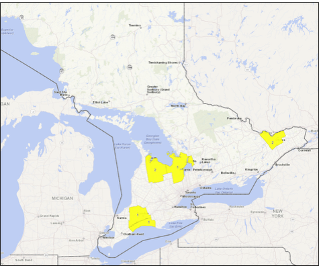 Strangles: During Q4 there were 4 new facilities managing Strangles located in: Perth County, District of Parry Sound, City of Hamilton and Simcoe County. There were 25 facilities affected by Strangles in 2024. 
AHL S. Equi PCR Testing Activity (as of 01/22/25)
Equine Influenza: In Q4, there were 6 facilities positive for influenza in the following counties: United Counties of Leeds and Grenville, Lanark County, City of Ottawa, Simcoe County, Northumberland County and the United Counties of Lennox and Addington. 8 facilities were positive for equine influenza in 2024.
West Nile virus: In Q4, 2 horses tested positive for WNV in Middlesex and Hastings Counties. A total of 11 horses were affected by WNV in 2024.
Eastern Equine Encephalitis: In Q4, one pony tested positive for EEE. In 2024, 24 equids were positive for EEE.
Q4 Equine Syndromic Surveillance: Graphs of disease syndromes based on samples sent for testing to the Animal Health Laboratory. This information is compiled based on the type of sample, test ordered, and key terms included in the submission history (if provided).
|
Syndromic and AHL Laboratory Data Surveillance
Survey – Key points
- 27 Counties represented
- 70% equine, 20% equine and food animal, 5% equine and small animal and 5% referral practice veterinarians responded.
- 24% of veterinarians reported working with performance/Competition/Show horses, 22% with pleasure/backyard horses, 18% with foals, breeding and young stock, 14% with draft horses, 11% with mules/donkeys, 8% with racehorses, and 4% with buggy horses.
- Increases in Q4 were noted for (foal): Chronic/recurrent mild respiratory diseases that take forever to resolve, pneumonia, Streptococcus zooepidemicus and S. equi infections, rotavirus, Lawsonia intracellularis.
- Increases in Q4 were noted for (adult): Equine asthma, EHV-1, EMPF, Strangles, colics (gas, impaction, surgical), gastric ulcers, enteritis, colitis, diarrhea with fever, EHM, EEE, allergic dermatitis, ringworm, tick-bite hypersensitivity, pastern dermatitis/leukocytoclastic vasculitis, EMS, insulin resistance, FUO (negative to FUO panel), FUO and dullness, Anaplasmosis, purpura hemorrhagica, general eye problems related to corneal ulceration, mediation and vaccine reactions, cellulitis, PSSM2, eosinophilic keratitis.
New conditions or those without a diagnosis:
- Non-PHF proximal enteritis
- Several FUOs, firm skin nodules over saddle area on clipped horses
- FUOs with low white cell counts that respond to flunixin meglumine
- Diarrhea with no fever nor colic
- Anaplasmosis
- Mastitis in a maiden/dry mare
- Diarrhea with fever
- 14 yo QH mare with acute severe signs, trying to thrash and roll. Distended small intestine on U/S. Normothermic. No reflux. Referred. The mare recovered well with medical management. Seemed like an ileal impaction which is unexpected for this region.
- Rotavirus
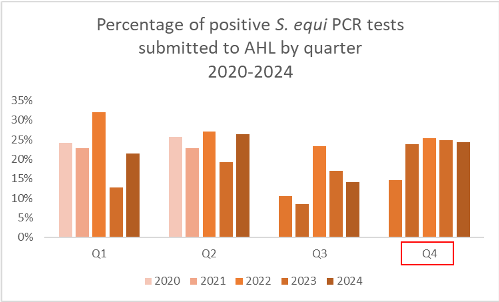
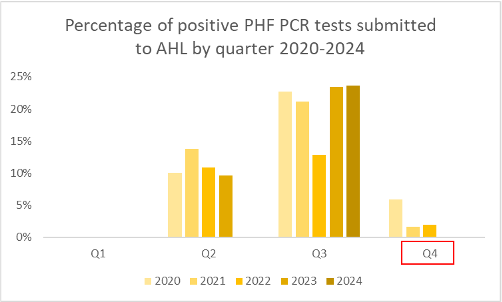
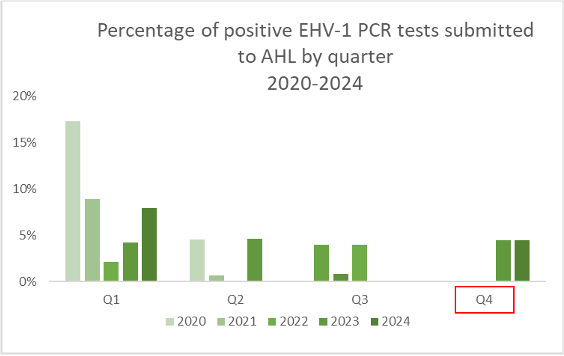
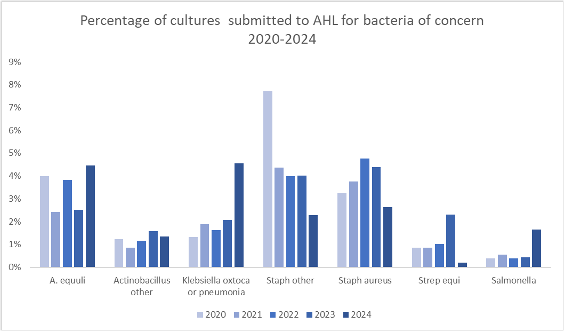
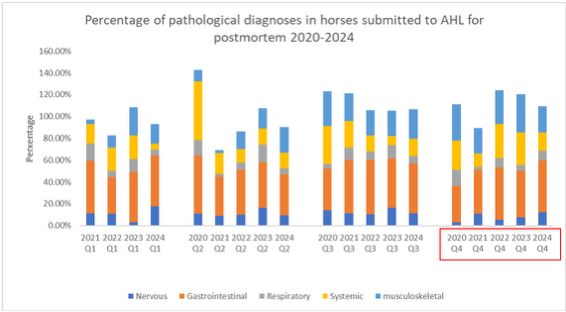
Equine Research from Ontario and Around the World
Researchers in Ontario
Effects of anesthetic protocol, procedure, and recovery stall and interval on the quality of recovery in repeatedly anesthetized horses. Henderson ARP, Valverde A, Koenig J, Sears W.Can J Vet Res. 2025 Jan;89(1):17-25.PMID: 39744466 Free PMC article.
Further Investigation Into an Environmental Source for Aminorex. Brooks L, Ryan M, McCosham E, Loganath
A Pilot Study to Assess the Safety and Efficacy of Umbilical Cord Blood-Derived Mesenchymal Stromal Cells for the Treatment of Synovitis in Horses. Seabaugh K, Rao S, Koenig JB, Pezzanite L, Dow S, Koch TG, Russell KA, Mehrpouyan S, Alizadeh AH, Goodrich LR.Animals (Basel). 2024 Nov 26;14(23):3406. doi: 10.3390/ani14233406.PMID: 39682372 Free PMC article.
Doping Control Analysis of Total Carbon Dioxide (TCO(2)) in Equine Plasma by Headspace Gas Chromatography-Mass Spectrometry (HS-GC/MS). Kwok KY, Kwok WH, Wan TSM, Brooks L, et al. .Drug Test Anal. 2024 Nov 25. doi: 10.1002/dta.3832. Online ahead of print.
Treatment approaches to horses with acute diarrhea admitted to referral institutions: A multicenter retrospective study. Gomez DE, et al. .PLoS One. 2024 Nov 20;19(11):e0313783. doi: 10.1371/journal.pone.0313783. eCollection 2024.PMID: 39565809 Free PMC article.
Endothelial glycocalyx degradation in critically ill foals. Gomez DE, Kamr A, Gilsenan WF, Burns TA, Mudge MC, Hostnik LD, Toribio RE.J Vet Intern Med. 2024 Sep-Oct;38(5):2748-2757. doi: 10.1111/jvim.17196. Epub 2024 Sep 14.PMID: 39275920 Free PMC article.
Researchers around the world
Behaviour
Mean mares? Habitat features influence female aggression in response to social instability in the feral horse (Equus caballus). Nuñez CMV, Adelman JS.Biol Lett. 2025 Jan;21(1):20240494. doi: 10.1098/rsbl.2024.0494. Epub 2025 Jan 15.
Assessment of horse behavior using an activity monitoring device used for cats and dogs. Matsubara T, Fukatsu R, Yamamoto M, Moriya M, Hano K, Nakamura K, Ohba Y, Takasu M.J Equine Sci. 2024 Dec;35(4):47-55. doi: 10.1294/jes.35.47. Epub 2024 Dec 12.PMID: 39670208 Free PMC article.
Behavioral and cardiac responses to a model startle test to assess retired Thoroughbred racehorses for equestrians. Ryu SH, Lee KE, Forbes E, An SJ, Kim JG, Lee H, Kim BS.J Vet Sci. 2024 Nov;25(6):e84. doi: 10.4142/jvs.24177.PMID: 39608778 Free PMC article.
Cardiology
Plasma Cardiac Troponin-I Concentration in Normal Horses and in Horses with Cardiac Abnormalities.Foreman JH, Tennent-Brown BS, Oyama MA, Sisson DD.Animals (Basel). 2025 Jan 3;15(1):92. doi: 10.3390/ani15010092.PMID: 39795035 Free PMC article.
Electrocardiograms from different types of exercise in Eventing horses with and without cardiac signs. Navas de Solis C, Solomon C, Durando M, Stefanovski D.Equine Vet J. 2024 Dec 4. doi: 10.1111/evj.14449. Online ahead of print.
Dentistry
Characterisation of equine odontoclastic tooth resorption and hypercementosis: A comparative study using microCT and radiography in age-matched controls. Nugent Z, Jensen A, Owen N, Peffers AJ, Moothanchery M, Peffers MJ.Equine Vet J. 2025 Jan 18. doi: 10.1111/evj.14453. Online ahead of print.
Inflammation and response to bacterial infection as potential drivers of equine odontoclastic tooth resorption and hypercementosis: A proteomics insight. Jensen A, Clarke EJ, Nugent Z, Paice E, Gringel I, Yamamoto K, Rocchigiani G, Peffers AJ, Cooper L, Peffers MJ.Equine Vet J. 2025 Jan 8. doi: 10.1111/evj.14469. Online ahead of print.
Dermatology
Interleukin 31 mediates pruritus in horses. Craig NM, Munguia NS, Trujillo AD, Chan AM, Wilkes R, Dorr M, Marsella R.Am J Vet Res. 2024 Oct 14;85(12):ajvr.24.05.0144. doi: 10.2460/ajvr.24.05.0144. Print 2024 Dec 1.PMID: 39406262 Free article.
Allergen immunotherapy using recombinant Culicoides allergens improves clinical signs of equine insect bite hypersensitivity. Graner A, Mueller RS, Geisler J, Bogenstätter D, White SJ, Jonsdottir S, Marti E.Front Allergy. 2024 Sep 30;5:1467245. doi: 10.3389/falgy.2024.1467245. eCollection 2024.PMID: 39403119 Free PMC article.
Gastroenterology
Influence of Saccharomyces cerevisiae CNCM I-1077 on the fecal pH, markers of gut permeability, fecal microbiota, and markers of systemic inflammation in sedentary horses fed a high-starch diet. Carter MM, Leatherwood JL, Paris BL, Moore GE, George JM, Martinez RE, Karges K, Cox JR, Arnold CE, Glass KG, Bradbery AN, Rodiles A, Wickersham TA.J Anim Sci. 2025 Jan 13:skaf005. doi: 10.1093/jas/skaf005. Online ahead of print.
Behavioral Signature of Equine Gastric Discomfort? Preliminary Retrospective Clinical Observations.Torcivia C, McDonnell SM.Animals (Basel). 2025 Jan 3;15(1):88. doi: 10.3390/ani15010088.PMID: 39795031 Free PMC article.
Clinicopathologic Parameters of Peritoneal Fluid as Predictors of Gastrointestinal Lesions, Complications, and Outcomes in Equine Colic Patients: A Retrospective Study. Martin E, Sarkan K, Viall A, Hostetter S, Epstein K.Animals (Basel). 2024 Dec 24;15(1):12. doi: 10.3390/ani15010012.PMID: 39794955 Free PMC article.
Changes in Immunoglobulins G and A in the Saliva and Serum of Horses with Equine Gastric Ulcer Syndrome (EGUS) and Their Relationship with Other Immune and Redox Status Biomarkers. Botía M, Martín-Cuervo M, Martínez-Subiela S, Cerón JJ, Ayala I, Hansen S, Muñoz-Prieto A.Biology (Basel). 2024 Nov 1;13(11):891. doi: 10.3390/biology13110891.PMID: 39596846 Free PMC article.
Preliminary Functional Analysis of the Gut Microbiome in Colic Horses. Thomson P, Garrido D, Santibáñez R, Lara F.Animals (Basel). 2024 Nov 10;14(22):3222. doi: 10.3390/ani14223222.PMID: 39595275 Free PMC article.
Association of Equine Squamous and Glandular Gastric Disease with Dental Status in 54 Horses. Lensing R, Wirth C, Thünker F, Merle R, Barton AK.Animals (Basel). 2024 Nov 7;14(22):3189. doi: 10.3390/ani14223189.PMID: 39595242 Free PMC article.
Improvement of gastric disease and ridden horse pain ethogram scores with diet adaptation in sport horses. Pineau V, Ter Woort F, Julien F, Vernant M, Lambey S, Hébert C, Hanne-Poujade S, Westergren V, van Erck-Westergren E.J Vet Intern Med. 2024 Nov-Dec;38(6):3297-3308. doi: 10.1111/jvim.17223. Epub 2024 Oct 28.PMID: 39465968 Free PMC article.
Stability of Gastric Fluid and Fecal Microbial Populations in Healthy Horses under Pasture and Stable Conditions. Bishop RC, Kemper AM, Clark LV, Wilkins PA, McCoy AM.Animals (Basel). 2024 Oct 16;14(20):2979. doi: 10.3390/ani14202979.PMID: 39457909 Free PMC article.
Health Management
Stakeholder Views on the Potential Benefits and Feasibility of an Equestrian Industry-Specific Health, Safety and Welfare Management System. Chapman M, Fenner K, Thomas MJW, Thompson K.Animals (Basel). 2024 Nov 28;14(23):3450. doi: 10.3390/ani14233450.PMID: 39682412 Free PMC article.
Horse Racing
Identification of a global gene expression signature associated with the genetic risk of catastrophic fracture in iPSC-derived osteoblasts from Thoroughbred horses. Palomino Lago E, Ross AKC, McClellan A, Guest DJ.Anim Genet. 2025 Feb;56(1):e13504. doi: 10.1111/age.13504.PMID: 39801206 Free PMC article.
Positive correlation between interleukin (IL) 1 beta to IL-1 receptor antagonist levels in Standardbred racehorses prior to racing. Chen JW, Stefanovski D, Haughan J, Jiang Z, Soma LR, Robinson MA.Vet Immunol Immunopathol. 2024 Dec 23;280:110868. doi: 10.1016/j.vetimm.2024.110868. Online ahead of print.PMID: 39793148 Free article.
Application of thermography in the assessment of physical effort on body surface temperature distribution in racehorses. Soroko-Dubrovina M, Śniegucka K, Dobrowolski M, Dudek KD.Pol J Vet Sci. 2024 Jun;27(2):221-227. doi: 10.24425/pjvs.2024.149352.
Comparative analysis of racing performance following surgical correction of epiglottic entrapment in standardbreds and thoroughbreds. Norton AM, Rosanowski SM, O’Brien T.Front Vet Sci. 2024 Nov 19;11:1479144. doi: 10.3389/fvets.2024.1479144. eCollection 2024.PMID: 39628869 Free PMC article.
Generalized sarcoidosis associated with hypertrophic osteopathy in a Standardbred racehorse. Charles A, Kerckhove HV, De Maré L, Cassart D, Ficheroulle J, Pouyade GR, Tosi I.J Equine Vet Sci. 2025 Jan;144:105249. doi: 10.1016/j.jevs.2024.105249. Epub 2024 Nov 28.
A machine learning approach to identify stride characteristics predictive of musculoskeletal injury, enforced rest and retirement in Thoroughbred racehorses. Bogossian PM, Nattala U, Wong ASM, Morrice-West AV, Zhang GZ, Rana P, Whitton RC, Hitchens PL.Sci Rep. 2024 Nov 22;14(1):28967. doi: 10.1038/s41598-024-79071-1.PMID: 39578597 Free PMC article.
Estimation of genetic parameters for racing time and ranking in Thoroughbred horses. de Oliveira Padilha DA, Padilha SF, Martins R, Scheffer BEM, Miliorini MR, Dias LT, Teixeira RA.J Equine Vet Sci. 2025 Jan;144:105244. doi: 10.1016/j.jevs.2024.105244. Epub 2024 Nov 19.
Evaluation of agreement for radiographic lesions and risk for racing in thoroughbred yearling sale repository radiographs. Argue BJ, Ahern BJ.Front Vet Sci. 2024 Oct 3;11:1430993. doi: 10.3389/fvets.2024.1430993. eCollection 2024.PMID: 39421830 Free PMC article.
Immune Response
Mare colostrum quality and relationship with foal serum immunoglobulin G concentrations and average daily weight gains. Gallacher K, Champion K, Denholm KS.Equine Vet J. 2025 Jan 15. doi: 10.1111/evj.14471. Online ahead of print.
Does dietary supplementation of pregnant mares with a commercial stud feed balancer improve the transfer of passive immunity in their foals? A controlled field trial. Stoneham SJ, Tyler N, Holmes MA, Archer DC.J Equine Vet Sci. 2025 Jan 6;145:105346. doi: 10.1016/j.jevs.2025.105346. Online ahead of print.
Infectious Disease
Detection of equine influenza virus gene in the air around infected horses. Nemoto M, Kawanishi N, Kambayashi Y, Bannai H, Yamanaka T, Tsujimura K.Vet Microbiol. 2025 Jan 11;302:110388. doi: 10.1016/j.vetmic.2025.110388. Online ahead of print.
Genomic analysis and replication kinetics of the closely related EHV-1 neuropathogenic 21P40 and abortigenic 97P70 strains. Mohamed E, Zarak I, Vereecke N, Theuns S, Laval K, Nauwynck H.Vet Res. 2025 Jan 13;56(1):12. doi: 10.1186/s13567-024-01434-3.PMID: 39806433 Free PMC article.
A model-based approach to evaluate the effect of vaccination of the herd on transmission of equine herpesvirus 1 in naturally occurring outbreaks. Houben RMAC, van Maanen C, Newton JR, van den Broek J, Sloet van Oldruitenborgh-Oosterbaan MM, Heesterbeek JAP.Prev Vet Med. 2025 Jan 4;236:106418. doi: 10.1016/j.prevetmed.2025.106418. Online ahead of print.PMID: 39798166 Free article.
Comparison of clinical variables and outcome of 2 natural equine herpesvirus myeloencephalopathy outbreaks induced by equine herpesvirus-1 A2254/N752 strain in sport horses. de la Cuesta-Torrado M, Velloso Alvarez A, Cárdenas-Rebollo JM, Neira-Egea P, Vitale V, Cuervo-Arango J.J Vet Intern Med. 2025 Jan-Feb;39(1):e17287. doi: 10.1111/jvim.17287.PMID: 39778904 Free PMC article.
Investigation of an Outbreak of Equine Herpesvirus-1 Myeloencephalopathy in a Population of Aged Working Equids.Pusterla N, Lawton K, Barnum S, Ross K, Purcell K.Viruses. 2024 Dec 21;16(12):1963. doi: 10.3390/v16121963.PMID: 39772269 Free PMC article.
Horse Innate Immunity in the Control of Equine Infectious Anemia Virus Infection: A Preliminary Study. Cardeti G, Manna G, Cersini A, Nardini R, Rosati S, Reina R, Cittadini M, Sittinieri S, Altigeri A, Marcario GA, Scicluna MT.Viruses. 2024 Nov 21;16(12):1804. doi: 10.3390/v16121804.PMID: 39772115 Free PMC article.
Comparison of nasal swabs and handmade foam cubes for detecting equine herpesvirus 5 (EHV-5) by quantitative polymerase chain reaction (qPCR). Charbonnel A, Lavoie JP, Juette T, St-Sauveur VG, Denis S, Gagnon CA, Leclère M.Can J Vet Res. 2025 Jan;89(1):11-16.PMID: 39744469 Free PMC article.
Should the equine community be concerned about the emergence of the H5N1 subtype of highly pathogenic avian influenza in US cattle? Murcia PR, Chambers TM, Daly JM, Pusterla N, Damdinjav B, Ankhanbaatar U, Mojsiejczuk L.Equine Vet J. 2024 Dec 11. doi: 10.1111/evj.14439. Online ahead of print.
Comments on ‘Should the equine community be concerned about the emergence of the H5N1 subtype of highly pathogenic avian influenza in US cattle?’. Newton JR, Whitlock F, Bryant N, van Maanen K.Equine Vet J. 2024 Dec 26. doi: 10.1111/evj.14460. Online ahead of print.
Evidence of Influenza A(H5N1) Spillover Infections in Horses, Mongolia. Damdinjav B, Raveendran S, Mojsiejczuk L, Ankhanbaatar U, Yang J, Sadeyen JR, Iqbal M, Perez DR, Rajao DS, Park A, Viana M, Murcia PR.Emerg Infect Dis. 2025 Jan;31(1):183-185. doi: 10.3201/eid3101.241266. Epub 2024 Dec 11.PMID: 39661025 Free PMC article.
Emerging Threats of Highly Pathogenic Avian Influenza A (H5N1) in US Dairy Cattle: Understanding Cross-Species Transmission Dynamics in Mammalian Hosts. Sreenivasan CC, Li F, Wang D.Viruses. 2024 Oct 30;16(11):1703. doi: 10.3390/v16111703.PMID: 39599818 Free PMC article. Review.
A comparative study evaluating three line immunoassays available for serodiagnosis of equine Lyme borreliosis: Detection of Borrelia burgdorferi sensu lato-specific antibodies in serum samples of vaccinated and non-vaccinated horses. Broeckl CV, Hiereth S, Straubinger RK.PLoS One. 2024 Dec 23;19(12):e0316170. doi: 10.1371/journal.pone.0316170. eCollection 2024.PMID: 39715214 Free PMC article.
Immunization but not natural infection of horses results in antibody activity against the S protein of Streptococcus equi subsp equi. Cohen ND, Hughes EV, Bayne C, Morris ERA, Bray JM, Landrock KK, Gonzales DM, Baker RM, Klein RL, Liu W, Legere RM, Wehmeyer SG, Bordin AI, Wierzbicki IH, Gonzalez DJ.Am J Vet Res. 2024 Dec 16:1-11. doi: 10.2460/ajvr.24.08.0228. Online ahead of print.PMID: 39681079 Free article.
Global prevalence of Borrelia burgdorferi and Anaplasma phagocytophilum coinfection in wild and domesticated animals: A systematic review and meta-analysis. Ma W, Gao L, Wu X, Zhong L, Huang X, Yang R, Wu H, Zhu L, Ma W, Peng L, Li B, Song J, Luo S, Bao F, Liu A.J Glob Health. 2024 Dec 6;14:04231. doi: 10.7189/jogh.14.04231.PMID: 39641312 Free PMC article.
Characterization of Nasal Mucosal T Cells in Horses and Their Response to Equine Herpesvirus Type 1.Holmes CM, Wagner B.Viruses. 2024 Sep 25;16(10):1514. doi: 10.3390/v16101514.PMID: 39459849 Free PMC article.
Bat-associated ticks as a potential link for vector-borne pathogen transmission between bats and other animals. Szentiványi T, Takács N, Sándor AD, Péter Á, Boldogh SA, Kováts D, Foster JT, Estók P, Hornok S.PLoS Negl Trop Dis. 2024 Oct 25;18(10):e0012584. doi: 10.1371/journal.pntd.0012584. eCollection 2024 Oct.PMID: 39453968 Free PMC article.
Epidemiological investigation of equine rotavirus B outbreaks in horses in central Kentucky. Sreenivasan CC, Naveed A, Uprety T, Soni S, Jacob O, Adam E, Wang D, Li F.Vet Microbiol. 2024 Nov;298:110278. doi: 10.1016/j.vetmic.2024.110278. Epub 2024 Oct 16.
Miscellaneous
Factors influencing equine veterinarians’ job satisfaction and retention: A focus group study. Whitaker K, Burnette A, Tan JY, Graves M, Hunt J, Devine E, Anderson S, Kirkendall K, Wisnieski L.Equine Vet J. 2025 Jan 10. doi: 10.1111/evj.14467. Online ahead of print.
Effect of Bio-Electro-Magnetic-Energy-Regulation (BEMER) Horse Therapy on Cardiopulmonary Function and Recovery Quality After Isoflurane Anesthesia in 100 Horses Subjected to Pars-Plana Vitrectomy: An Investigator-Blinded Clinical Study. Brandenberger O, Kalinovskiy A, Körner J, Genn H, Burger R, Leser S.Animals (Basel). 2024 Dec 18;14(24):3654. doi: 10.3390/ani14243654.PMID: 39765558 Free PMC article.
Essential oil supplementation improves insulin sensitivity and modulates the plasma metabolome of hyperinsulinemic horses. Loos CMM, Zhao S, Li L, Li J, Han W, Vanzant ES, McLeod KR.Front Vet Sci. 2024 Dec 2;11:1444581. doi: 10.3389/fvets.2024.1444581. eCollection 2024.PMID: 39687851 Free PMC article.
Ice application without water drainage supports optimal hoof cooling in adult horses. Folk KM, White RR, Gleason CB.J Equine Vet Sci. 2024 Dec 5;145:105255. doi: 10.1016/j.jevs.2024.105255. Online ahead of print.
A Survey of Veterinary Student Perceptions on Integrating ChatGPT in Veterinary Education Through AI-Driven Exercises.Alonso Sousa S, Flay KJ.J Vet Med Educ. 2024 Dec 13:e20240075. doi: 10.3138/jvme-2024-0075. Online ahead of print.
Impact of equine interactions on human acute pain perception: Two cross sectional studies. Doherty-Sneddon G, Caiazza R, Pawlowska E, Vuong Q.Br J Pain. 2024 Nov 29:20494637241302391. doi: 10.1177/20494637241302391. Online ahead of print.PMID: 39619499 Free PMC article.
Challenges for the veterinary profession: A grounded theory study of veterinarians’ experiences of caring for older horses. Smith R, Pinchbeck G, McGowan C, Ireland J, Perkins E.Equine Vet J. 2024 Nov 27. doi: 10.1111/evj.14444. Online ahead of print.
Clinical and pathological findings of Africanized bee (Apis mellifera) envenomation in horses. Costa Kamura BD, Albertino LG, Cavallari RR, Queiroz de Souza L, Rodrigues LT, Barros de Sousa Pereira I, Rocha NS, Takahira RK, Briscola Pereira WA, Borges AS, Oliveira-Filho JP, Amorim RM.Toxicon. 2024 Nov 28;251:108136. doi: 10.1016/j.toxicon.2024.108136. Epub 2024 Oct 19.
Muscle
Muscle Rehabilitation Techniques and Prevention of Injury. King MR, Colla S.Vet Clin North Am Equine Pract. 2025 Jan 8:S0749-0739(24)00103-2. doi: 10.1016/j.cveq.2024.11.010. Online ahead of print.
Comparison of long- and short-rest periods during high-intensity interval exercise on transcriptomic responses in equine skeletal muscle. Takahashi K, Mukai K, Takahashi Y, Ebisuda Y, Hatta H, Kitaoka Y.Physiol Genomics. 2025 Jan 1;57(1):28-39. doi: 10.1152/physiolgenomics.00066.2024. Epub 2024 Dec 11.PMID: 39661768
Neonatology
Retrospective cohort study on diseases and risk factors associated with death in hospitalized neonatal foals. Castelain DL, Dufourni A, Pas ML, Bokma J, de Bruijn E, Paulussen E, Lefère L, van Loon G, Pardon B.J Vet Intern Med. 2025 Jan-Feb;39(1):e17269. doi: 10.1111/jvim.17269.PMID: 39690128 Free PMC article.
Changes in blood physiological and biochemical parameters and intestinal flora in newborn horses and mares with angular limb deformities. Ma Y, Liu Y, Li H, Yang K, Yao G.Front Vet Sci. 2024 Nov 26;11:1503117. doi: 10.3389/fvets.2024.1503117. eCollection 2024.PMID: 39660173 Free PMC article.
Neurology
Neurotoxic phospholipase A(2): A proposed cause of equine grass sickness and other animal dysautonomias (multiple system neuropathies). McGorum B, Pirie RS, Bano L, Davey T, Harris J, Montecucco C.Equine Vet J. 2025 Jan;57(1):11-18. doi: 10.1111/evj.14442.
Effect of refrigeration, room temperature, and processing time on serum immunofluorescent antibody titers for Sarcocystis neurona. Valderrama-Martinez C, Packham A, Zheng S, Smith W, Plancarte M, Aleman M.J Vet Intern Med. 2025 Jan-Feb;39(1):e17282. doi: 10.1111/jvim.17282.PMID: 39715359 Free PMC article.
Pneumocephalus due to temporohyoid osteoarthropathy in a 16-year-old Friesian mare. Witt P, Stas EKL, Hardeman LC, van Proosdij ER, Weerts EAWS, Lloyd-Edwards RA, Veraa S, Kranenburg LC, van den Boom R.J Equine Vet Sci. 2024 Dec;143:105210. doi: 10.1016/j.jevs.2024.105210. Epub 2024 Oct 26.
Urinary incontinence and sabulous cystitis in mares: report of five cases. de Melo UP, Ferreira C.Braz J Vet Med. 2024 Oct 21;46:e005024. doi: 10.29374/2527-2179.bjvm005024. eCollection 2024.PMID: 39450000 Free PMC article.
Nutrition
Influence of Dietary Cobalt on Fiber Digestibility and Serum Cobalt and Cobalamin Concentrations in Horses. LeCompte Lazić RA, Nielsen BD, Robison CI, Schott HC 2nd, Herdt TH, Larson CK.Animals (Basel). 2024 Dec 12;14(24):3595. doi: 10.3390/ani14243595.PMID: 39765500 Free PMC article.
Nutraceutical Supplement Mitigates Insulin Resistance in Horses with a History of Insulin Dysregulation During a Challenge with a High-Starch Diet. Loos C, Castelein A, Vanzant E, Adam E, McLeod KR.Animals (Basel). 2024 Nov 25;14(23):3385. doi: 10.3390/ani14233385.PMID: 39682351 Free PMC article.
A Meta-Analysis on Quantitative Calcium, Phosphorus and Magnesium Metabolism in Horses and Ponies. Maier I, Kienzle E.Animals (Basel). 2024 Sep 25;14(19):2765. doi: 10.3390/ani14192765.PMID: 39409714 Free PMC article. Review.
Metabolomic analysis of the impact of red ginseng on equine physiology. Kwak YB, Stambler I, Yoo HH, Yoon J.Front Vet Sci. 2024 Sep 30;11:1425089. doi: 10.3389/fvets.2024.1425089. eCollection 2024.PMID: 39403214 Free PMC article.
Ophthalmology
Clinical and morphological features of corneal lymphoma in 26 horses (27 eyes). Morris JM, Lassaline ME, Nunnery CM, Teixeira LBC, Martins BC, Moore BA, Knickelbein KE, Sherrer NM, Plummer CE.Equine Vet J. 2024 Nov 27. doi: 10.1111/evj.14446. Online ahead of print.
Orthopedics
Correlation of fecal microbiome dysregulation to synovial transcriptome in an equine model of obesity associated osteoarthritis.Chow L, Kawahisa-Piquini G, Bass L, Hendrickson D, Patel A, Rockow M, Dow S, Pezzanite LM.Ann Transl Med. 2024 Dec 24;12(6):112. doi: 10.21037/atm-24-109. Epub 2024 Dec 13.PMID: 39817240 Free PMC article.
Fetal Cartilage Progenitor Cells in the Repair of Osteochondral Defects. Menarim BC, Mok CH, Scoggin KE, Gornik A, Adam EN, Loux SC, MacLeod JN.JB JS Open Access. 2025 Jan 15;10(1):e24.00043. doi: 10.2106/JBJS.OA.24.00043. eCollection 2025 Jan-Mar.PMID: 39817152 Free PMC article.
Role of cannabidiolic acid or the combination of cannabigerol/cannabidiol in pain modulation and welfare improvement in horses with chronic osteoarthritis. Aragona F, Tabbì M, Gugliandolo E, Giannetto C, D’Angelo F, Fazio F, Interlandi C.Front Vet Sci. 2024 Dec 10;11:1496473. doi: 10.3389/fvets.2024.1496473. eCollection 2024.PMID: 39720409 Free PMC article.
Temporal kinetics of serum amyloid A (SAA) concentration and identification of SAA isoforms in blood and synovial fluid of horses with experimentally induced septic arthritis, non-septic synovitis, and systemic inflammation.Koziy RV, Katselis GS, Yoshimura S, Simko E, Bracamonte JL.J Vet Diagn Invest. 2024 Dec 17:10406387241299873. doi: 10.1177/10406387241299873. Online ahead of print.PMID: 39688235 Free PMC article.
Extracellular Vesicles: A Novel Diagnostic Tool and Potential Therapeutic Approach for Equine Osteoarthritis. Elashry MI, Speer J, De Marco I, Klymiuk MC, Wenisch S, Arnhold S.Curr Issues Mol Biol. 2024 Nov 17;46(11):13078-13104. doi: 10.3390/cimb46110780.PMID: 39590374 Free PMC article. Review.
Does a relation between bone histomorphometry and fractures exist? The case of the equine radius and tibia. Zedda M, Babosova R, Gadau S, Lepore G, Succu S, Farina V.Vet Med (Praha). 2024 Sep 26;69(9):307-313. doi: 10.17221/18/2024-VETMED. eCollection 2024 Sep.PMID: 39474360 Free PMC article.
Genetic factors of equine osteochondrosis and fetlock osteochondral fragments: A scoping review – Part 2. Van Mol B, Janssens S, Oosterlinck M, Pille F, Buys N.Vet J. 2024 Dec;308:106258. doi: 10.1016/j.tvjl.2024.106258. Epub 2024 Oct 22.
Parasitology
Deworming programs for horses in the United States: past, present, and future. Turner JL.Anim Front. 2024 Oct 14;14(5):32-34. doi: 10.1093/af/vfae018. eCollection 2024 Oct.PMID: 39411333 Free PMC article.
Pharmacology
Short-term clinical and biochemical responses following treatment with dapagliflozin or ertugliflozin in horses with hyperinsulinemia: A retrospective case series. Sundra T, Knowles E, Rendle D, Kelty E, Lester G, Rossi G.Domest Anim Endocrinol. 2025 Jan;90:106894. doi: 10.1016/j.domaniend.2024.106894. Epub 2024 Nov 19.PMID: 39581155 Free article.
Effect of furosemide on comprehensive renin-angiotensin-aldosterone system activity of Thoroughbred horses. Lehman ML, Domenig O, Ames MK, Morgan JM.J Vet Intern Med. 2024 Nov-Dec;38(6):3272-3280. doi: 10.1111/jvim.17208. Epub 2024 Oct 22.PMID: 39434560 Free PMC article.
Reproduction
Real-time transrectal ultrasonographic measurement of the fetal eye (vitreous body) to predict parturition in bucking horse mares. Gonzalez SW, Espy BMK, Stefanovski D, Turner RM.J Equine Vet Sci. 2025 Jan 3;145:105345. doi: 10.1016/j.jevs.2025.105345. Online ahead of print.
Foals born alive from mares with ultrasonographically assessed placental abnormalities: Neonatal health and development up to weaning compared to foals from healthy mares. Debes L, Venner M, Koether K, Vervuert I, Blanco M, Sieme H, Sielhorst J.Theriogenology. 2024 Dec 29;235:31-38. doi: 10.1016/j.theriogenology.2024.12.025. Online ahead of print.PMID: 39756113
Fluctuations of antimüllerian hormone, ovarian follicular reserve, and antioxidant status throughout the estrous cycle in aged mares. Aboelmaaty AM, Elgharieb AEA, El-Debaky HA, Alkhadrawy JMH, Abou-Ahmed MM, Ghallab AM.Open Vet J. 2024 Nov;14(11):3132-3143. doi: 10.5455/OVJ.2024.v14.i11.44. Epub 2024 Nov 30.PMID: 39737015 Free PMC article.
Prostaglandin pathways in equine myometrium regulations: endometrosis progression. Piotrowska-Tomala KK, Szóstek-Mioduchowska AZ, Drzewiecka EM, Jonczyk AW, Wójtowicz A, Wrobel MH, Ferreira-Dias G, Skarzynski DJ.Front Vet Sci. 2024 Dec 5;11:1479508. doi: 10.3389/fvets.2024.1479508. eCollection 2024.PMID: 39735588 Free PMC article.
Respiratory
A genome-wide association study for recurrent laryngeal neuropathy in the Thoroughbred horse identifies a candidate gene that regulates myelin structure. McGivney CL, McGivney BA, Farries G, Gough KF, Han H, Holtby AR, MacHugh DE, Katz LM, Hill EW.Equine Vet J. 2025 Jan 10. doi: 10.1111/evj.14461. Online ahead of print.
Survey of the approach to the diagnosis and management of bacterial pneumonia in adult horses by equine veterinarians. Hepworth-Warren KL, Love K.Front Vet Sci. 2024 Dec 23;11:1484970. doi: 10.3389/fvets.2024.1484970. eCollection 2024.PMID: 39764370 Free PMC article.
Pilot study characterizing a single pooled preparation of equine platelet lysate for nebulization in the horse. Egli P, Boone L, Huber L, Higgins C, Gaonkar PP, Arrington J, Naskou MC, Peroni J, Gordon J, Lascola KM.Front Vet Sci. 2024 Dec 12;11:1488942. doi: 10.3389/fvets.2024.1488942. eCollection 2024.PMID: 39726585 Free PMC article.
Equine Asthma Diagnostics: Review of Influencing Factors and Difficulties in Diagnosing Subclinical Disease. Lendl L, Barton AK.Animals (Basel). 2024 Dec 4;14(23):3504. doi: 10.3390/ani14233504.PMID: 39682469 Free PMC article. Review.
The Role of Viral Pathogens in Horse Respiratory Diseases: A Cytological and Molecular Approach Using Next-Generation Sequencing. Mazzei M, Sorvillo B, Sgorbini M, Bindi F, Perelli A, Laus F.Animals (Basel). 2024 Nov 21;14(23):3347. doi: 10.3390/ani14233347.PMID: 39682313 Free PMC article.
Transport-related respiratory pathogens in horses travelling long distances: A prospective study on arrival at the slaughterhouse. Padalino B, Pellegrini F, Felici M, Zappaterra M, Catella C, Cordisco M, Lorusso E, Cirone F, Pratelli A.Res Vet Sci. 2025 Feb;183:105498. doi: 10.1016/j.rvsc.2024.105498. Epub 2024 Dec 7.PMID: 39667086 Free article.
Clinical efficacy of inhaled corticosteroids in equine asthma: A meta-analysis and number needed to treat. Pistocchini E, Carrillo Heredero AM, Mazan M, Couetil L, Bertini S, Calzetta L.Pulm Pharmacol Ther. 2024 Dec 5;88:102342. doi: 10.1016/j.pupt.2024.102342. Online ahead of print.PMID: 39645223 Free article.
Serum Vitamin D Level Is Unchanged in Equine Asthma. Mainguy-Seers S, Holcombe SJ, Lavoie JP.Animals (Basel). 2024 Nov 18;14(22):3310. doi: 10.3390/ani14223310.PMID: 39595361 Free PMC article.
Distinct Molecular Profiles Underpin Mild-To-Moderate Equine Asthma Cytological Profiles. Karagianni AE, Richard EA, Toquet MP, Hue ES, Courouce-Malblanc A, McGorum B, Kurian D, Aguilar J, Mazeri S, Wishart TM, Pirie RS.Cells. 2024 Nov 20;13(22):1926. doi: 10.3390/cells13221926.PMID: 39594673 Free PMC article.
A first step towards objective grading of equine laryngeal function. Hardwick J, Ahern B, Franklin S.Vet J. 2024 Dec;308:106259. doi: 10.1016/j.tvjl.2024.106259. Epub 2024 Oct 26.PMID: 39490435 Free article.
Oxygen consumption, locomotory-respiratory coupling and exercise-induced pulmonary hemorrhage in horses during the Paso Fino gait. Massie S, Léguillette R, Bayly W, Sides R, Zuluaga-Cabrera AM.J Vet Intern Med. 2024 Nov-Dec;38(6):3337-3345. doi: 10.1111/jvim.17226. Epub 2024 Oct 31.PMID: 39482263 Free PMC article.
Increased freedom of head movement mitigates stress and bacterial load in the airways of horses during transport. Takahashi Y, Niwa H, Ebisuda Y, Mukai K, Yoshida T, Raidal S, Padalino B, Ohmura H.Front Vet Sci. 2024 Oct 4;11:1477653. doi: 10.3389/fvets.2024.1477653. eCollection 2024.PMID: 39430384 Free PMC article.
Exposure to respirable silica contributes to lower airway inflammation in asthmatic horses. Romolo A, Costa G, Sica B, Memoli G, Ardit M, Di Benedetto F, Bellis D, Capella S, Belluso E, Bullone M.J Vet Intern Med. 2024 Nov-Dec;38(6):3315-3326. doi: 10.1111/jvim.17160. Epub 2024 Oct 17.PMID: 39417308 Free PMC article.
Sports medicine
AI-assisted Digital Video Analysis Reveals Changes in Gait Among Three-Day Event Horses During Competition. Smythe MP, Dewberry LS, Staiger EA, Allen K, Brooks SA.J Equine Vet Sci. 2025 Jan 6:105344. doi: 10.1016/j.jevs.2025.105344. Online ahead of print.
Applying Multi-Purpose Commercial Inertial Sensors for Monitoring Equine Locomotion in Equestrian Training. Fercher C, Bartsch J, Kluge S, Schneider F, Liedtke AM, Schleichardt A, Ueberschär O.Sensors (Basel). 2024 Dec 21;24(24):8170. doi: 10.3390/s24248170.PMID: 39771905 Free PMC article.
Potential use of beet-pulp concentrate supplementation in athletic horse. Souza LA, Hunka MM, Rezende Júnior SF, Silva CJFLD, Manso HECDCC, Simões J, Coelho CS, Fazio F, Aragona F, Manso Filho HC.Heliyon. 2024 Dec 10;11(1):e40961. doi: 10.1016/j.heliyon.2024.e40961. eCollection 2025 Jan 15.PMID: 39758378 Free PMC article.
Factors associated with the selling price of sport horses in public auctions in Ireland. Corbally AF, Fahey AG.J Equine Vet Sci. 2025 Jan 3:105347. doi: 10.1016/j.jevs.2025.105347. Online ahead of print.
Ethylene glycol toxicosis in 39 sport horses following ingestion of contaminated water: A case report. Daradics Z, Bungărdean D, Lupșan AF, Popescu M, Bulmez O, Ciulu-Angelescu V, Chelaru VF, Morar I, Mircean M, Cătoi C, Tripon MA, Crecan CM.J Equine Vet Sci. 2025 Jan 2;145:105343. doi: 10.1016/j.jevs.2025.105343. Online ahead of print.
Soft palate angle and basihyoid depth increase with tongue size and with body condition score in horses. Talbot AM, Shanks-Boon H, Baldwin CM, Barnes H, Maddox TW.Equine Vet J. 2025 Jan 2. doi: 10.1111/evj.14445. Online ahead of print.
Quantitative lameness assessment in horses by using an accelerometer-based simple device: A preliminary study. Crecan CM, Ciulu-Angelescu V, Morar IA, Lupșan AF, Tripon MA, Tripon MA, Bungărdean D, Daradics Z, Peștean CP.Open Vet J. 2024 Nov;14(11):3089-3099. doi: 10.5455/OVJ.2024.v14.i11.38. Epub 2024 Nov 30.PMID: 39737023 Free PMC article.
Climate change impact on blood haemogram in the horse: a three-year preliminary study. Deniz Ö, Aragona F, Murphy BA, Tümer KÇ, Bozacı S, Fazio F.Front Vet Sci. 2024 Dec 16;11:1482268. doi: 10.3389/fvets.2024.1482268. eCollection 2024.PMID: 39736933 Free PMC article.
The rhythm of horse gaits. Laffi L, Raimondi T, Ferrante C, Pagliara E, Bertuglia A, Briefer EF, Gamba M, Ravignani A.Ann N Y Acad Sci. 2024 Dec 28. doi: 10.1111/nyas.15271. Online ahead of print.
Effect of a dietary nutraceutical “STRUCTURE-Joint” on response of horses to intra-articular challenge with IL-1: implications for tissue adaptation to stress. Korac L, Golestani N, MacNicol J, Souccar-Young J, Witherspoon S, Wildish A, Topfer S, Pearson W.Transl Anim Sci. 2024 Dec 7;8:txae172. doi: 10.1093/tas/txae172. eCollection 2024.PMID: 39713786 Free PMC article.
Effect of hay nets on subluxations, pain-pressure thresholds, and cervical range of motion in the axial skeleton of adult horses. DeBoer M, Rieck T, Johnson L, Redenius H, Martinson K.J Equine Vet Sci. 2024 Dec 5;145:105256. doi: 10.1016/j.jevs.2024.105256. Online ahead of print.
Performance of Warmblood horses following tenoscopic desmotomy of the main part of the accessory ligament of the superficial digital flexor tendon for treatment of tendinopathy: 62 cases. Blatter M, Chapman HS, Heinzel-Gutenbrunner M, von Plato G, Rijkenhuizen A.Equine Vet J. 2024 Dec 5. doi: 10.1111/evj.14437. Online ahead of print.
A review of the equine suspensory ligament: Injury prone yet understudied. Guest DJ, Birch HL, Thorpe CT.Equine Vet J. 2024 Nov 27. doi: 10.1111/evj.14447. Online ahead of print.
Monitoring of Non-Lame Horses and Horses with Unilateral Hindlimb Lameness at Rest with the Aid of Accelerometers. Uellendahl A, Schramel JP, Tichy A, Peham C.Sensors (Basel). 2024 Nov 11;24(22):7203. doi: 10.3390/s24227203.PMID: 39598979 Free PMC article.
Hair and Blood Trace Elements (Cadmium, Zinc, Chrome, Lead, Iron and Copper) Biomonitoring in the Athletic Horse: The Potential Role of Haematological Parameters as Biomarkers. Aragona F, Giannetto C, Piccione G, Licata P, Deniz Ö, Fazio F.Animals (Basel). 2024 Nov 8;14(22):3206. doi: 10.3390/ani14223206.PMID: 39595259 Free PMC article.
Autonomic regulation in athletic horses repetitively participating in two novice jumping classes on consecutive days. Wonghanchao T, Huangsaksri O, Sanigavatee K, Poochipakorn C, Chanprame S, Wongkosoljit S, Chotiyothin W, Rattanayanon N, Kiawwan R, Chanda M.Front Vet Sci. 2024 Oct 22;11:1456733. doi: 10.3389/fvets.2024.1456733. eCollection 2024.PMID: 39502949 Free PMC article.
Rein tensions and behaviour with five rein types in international-level vaulting horses. Biau S, Pycik E, Boichot L, Berg LC, Ruet A.PLoS One. 2024 Oct 17;19(10):e0311919. doi: 10.1371/journal.pone.0311919. eCollection 2024.PMID: 39418261 Free PMC article.
Sports medicine – bone and joint
The Combined Use of Triamcinolone and Platelet-Rich Plasma in Equine Metacarpophalangeal Joint Osteoarthritis Treatments: An In Vivo and In Vitro Study. Guidoni K, Chiaradia E, Pepe M, Di Meo A, Tognoloni A, Seccaroni M, Beccati F.Animals (Basel). 2024 Dec 17;14(24):3645. doi: 10.3390/ani14243645.
A Pilot Study to Assess the Safety and Efficacy of Umbilical Cord Blood-Derived Mesenchymal Stromal Cells for the Treatment of Synovitis in Horses. Seabaugh K, Rao S, Koenig JB, Pezzanite L, Dow S, Koch TG, Russell KA, Mehrpouyan S, Alizadeh AH, Goodrich LR.Animals (Basel). 2024 Nov 26;14(23):3406. doi: 10.3390/ani14233406.PMID: 39682372 Free PMC article.
Double-blinded, randomized tolerance study of a biologically enhanced Nanogel with endothelin-1 and bradykinin receptor antagonist peptides via intra-articular injection for osteoarthritis treatment in horses.Terlinden A, Jacquet S, Manivong S, Cullier A, Cassé F, Legendre F, Garcia AA, Roullin G, Moldovan F, Sirois P, Banquy X, Galéra P, Audigié F, Demoor M, Bertoni L.BMC Vet Res. 2024 Dec 4;20(1):547. doi: 10.1186/s12917-024-04352-w.PMID: 39633332 Free PMC article.
Clinical insights: Upper appendicular, pelvic and axial skeletal pathology with poor performance. Trumble TN.Equine Vet J. 2025 Jan;57(1):5-10. doi: 10.1111/evj.14440.
Welfare
Assessment of ante mortem welfare indicators and the pathophysiology of captive-bolt trauma in equids at slaughter. Fletcher KA, Padalino B, Felici M, Bigi D, Limon-Vega G, Grist A, Gibson TJ.Anim Welf. 2025 Jan 3;33:e65. doi: 10.1017/awf.2024.70. eCollection 2024.PMID: 39777369 Free PMC article.
Anticipatory Behaviour During the Approach to Feeding Times as a Measure of Horse Welfare. Mata F, Boyton G, Young T.Animals (Basel). 2024 Dec 20;14(24):3677. doi: 10.3390/ani14243677.PMID: 39765580 Free PMC article.
Impact of musical rhythm on blood, physiological and welfare parameters in stabled horses. Oliveira FYU, Odakura AM, de Castro Burbarelli MF, Ouros CCD, de Lima Almeida Paz IC, Braz JM, Garcia RG, Caldara FR.Sci Rep. 2024 Dec 28;14(1):31311. doi: 10.1038/s41598-024-82637-8.PMID: 39732892 Free PMC article.
Facial pressure beneath a cavesson noseband adjusted to different tightness levels during standing and chewing. Clayton HM, Murray R, Williams JM, Walker V, Fisher M, Fisher D, Nixon J, Mackechnie-Guire R.Equine Vet J. 2024 Dec 22. doi: 10.1111/evj.14451. Online ahead of print.
Global distribution and gap analysis of equine housing research: The findings so far and where to go next.Robertson T, Thomas E, Starbuck G, Yarnell K.Anim Welf. 2024 Dec 11;33:e58. doi: 10.1017/awf.2024.64. eCollection 2024.PMID: 39703212 Free PMC article.
Forage, freedom of movement, and social interactions remain essential fundamentals for the welfare of high-level sport horses. Phelipon R, Hennes N, Ruet A, Bret-Morel A, Górecka-Bruzda A, Lansade L.Front Vet Sci. 2024 Nov 20;11:1504116. doi: 10.3389/fvets.2024.1504116. eCollection 2024.PMID: 39634765 Free PMC article.
Living the good life? A systematic review of behavioural signs of affective state in the domestic horse (Equus caballus) and factors relating to quality of life. Part I: Fulfilment of species-specific needs. Hall C, Kay R.Anim Welf. 2024 Oct 21;33:e40. doi: 10.1017/awf.2024.38. eCollection 2024.PMID: 39464387 Free PMC article.
Ontario equine disease surveillance summary
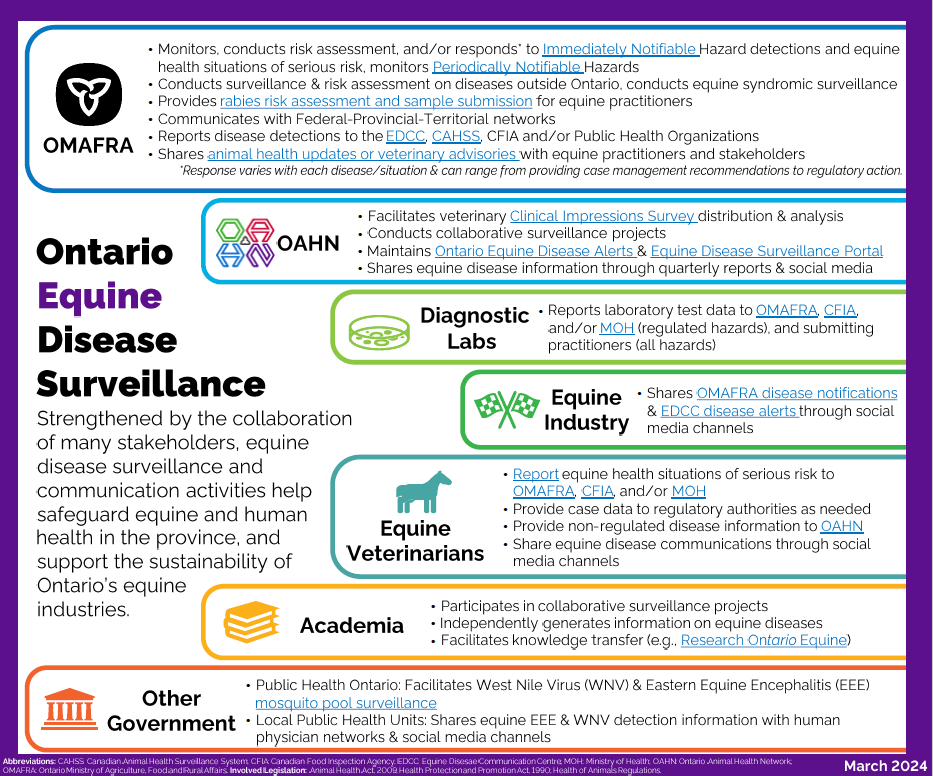
Equine disease surveillance in Ontario is a collaborative effort involving many public and private stakeholders. Diagnostic results generated by veterinary laboratories, clinical impression and case data provided by equine veterinarians, disease detections reported outside of Ontario by independent organizations, vector surveillance conducted by human health agencies, and research projects facilitated by Academic institutions or the Ontario Animal Health Network (OAHN), are all key sources of surveillance data. Strong communication between these stakeholders and with horse owners and caretakers supports both equine and human health in Ontario.
Please follow the links in the summary above for additional information on the associated activities or organizations and for many resources useful to equine industry members.
ResearchONequine.ca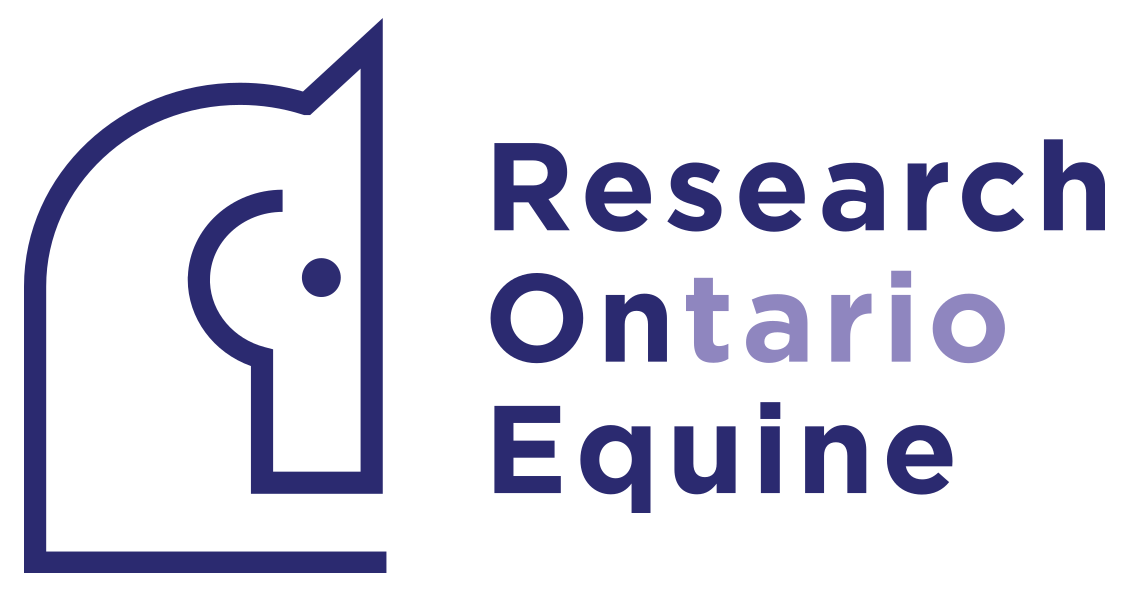 is a website developed by the Ontario Animal Health Network equine network to help increase research awareness and to connect researchers from academia, industry and government with the ultimate goal of improving the lives of all equines. It was supported by OAHN and the Ontario Association of Equine Practitioners.
is a website developed by the Ontario Animal Health Network equine network to help increase research awareness and to connect researchers from academia, industry and government with the ultimate goal of improving the lives of all equines. It was supported by OAHN and the Ontario Association of Equine Practitioners.
